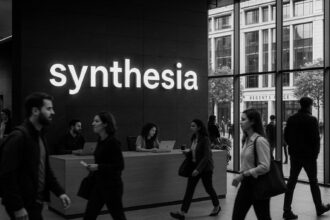Dan Shapero, LinkedIn’s COO, reveals practical ways he integrates AI into his work routine—from meeting summaries to learning new topics—while stressing the irreplaceable value of human judgement in leadership roles.
Dan Shapero, Chief Operating Officer of LinkedIn, has detailed his practical use of artificial intelligence (AI) in his professional routine, emphasising the importance for business leaders to engage actively with AI technology. Speaking to Business Insider, Shapero noted that as LinkedIn continues to introduce AI-driven products, he himself has been incorporating AI tools to enhance efficiency and stay informed.
Shapero outlined three specific ways he uses AI in his daily work:
-
Meeting Summaries: Shapero acknowledged that he cannot attend every meeting but values the information shared. To bridge this gap, he relies on AI — particularly Microsoft’s Copilot integrated with Teams — to provide concise summaries of meetings he misses. “I’ll often use Copilot to summarize meeting outcomes to make sure that I can stay on top of the business,” he said.
-
Learning New Topics: When faced with unfamiliar subjects such as emerging technologies, new legislation, or evolving industry trends, Shapero turns to conversational AI tools like ChatGPT. He described this approach as “very helpful” for gaining a deep understanding of complex topics quickly.
-
Meeting Preparation: To economise time in preparing for meetings, Shapero uses LinkedIn’s own Account IQ product, which compiles recent company news, LinkedIn activity, hiring trends, and other relevant data into a succinct dossier. “It takes all the news that’s been going on around a company… and it summarizes it into a one-page dossier that I can then read to be prepared for my discussion,” he explained.
Additionally, Shapero employs AI chatbots to improve the clarity and effectiveness of his written and oral communication. However, he pointed out that he still prefers to craft his own profile on LinkedIn manually, given his experience with first-person writing.
Despite these numerous advantages, Shapero emphasised that AI cannot replace essential human elements of his role. He particularly highlighted recruitment, stating that while AI can assist in sourcing and shortlisting candidates, determining cultural fit and persuading candidates remain personal, human-driven tasks: “How do I really assess whether they’re a good fit for the job? How do I have a conversation with them to convince them that we’re a good match for them?”
Furthermore, he expressed scepticism regarding AI’s ability to fulfil leadership roles, suggesting that AI has yet to demonstrate capabilities such as team inspiration or forming deeper human connections. Shapero also noted that the limitations of AI tools, especially when they face data scarcity, mean “Ultimately it has to be you at the centre, making the decision and seeing the path forward.”
Addressing business leaders broadly, Shapero advised they become comfortable and proficient with AI technologies, as they will likely be questioned by CEOs and boards about their AI strategies. “The leaders who have good answers to those questions will be successful in the next decade,” he stated.
Shapero’s insights reflect a growing trend among technology executives integrating AI into workflows while recognising the ongoing necessity for human judgment and leadership. Other notable tech figures, including Nvidia’s Jensen Huang and OpenAI’s Sam Altman, have reported daily AI use, with some, such as Shopify’s CEO Tobe Lütke, even mandating AI deployment across their companies.
The AOL.com report concludes that AI is increasingly shaping executive functions within major technology companies, marking a significant shift in workplace productivity and decision-making processes.
Source: Noah Wire Services
- https://www.businessinsider.com/linkedin-dan-shapero-interview-2024-outlook-amazed-by-ai-2023-12 – This article contains detailed quotes from Dan Shapero, COO of LinkedIn, about his use of AI in daily work, including the use of Microsoft Copilot for meeting summaries and ChatGPT for learning new topics, corroborating his personal AI applications as described.
- https://www.citigroup.com/global/insights/linkedin-chief-operating-officer-on-ai-at-work – This source features Dan Shapero discussing how AI is transforming work at LinkedIn, including AI-driven products and business leaders’ need to engage actively with AI technology, supporting the article’s emphasis on AI integration into leadership workflows.
- https://fortune.com/europe/2024/12/19/linkedin-coo-workers-be-prepared-ai-question-job-interviews/ – This article highlights Dan Shapero’s advice to workers about being prepared to talk about how they use AI in their professional lives, underpinning his broader message about business leaders and employees embracing AI competence.
- https://blogs.nvidia.com/blog/2023/11/10/ai-in-daily-work-nvidia-ceo-jensen-huang/ – Nvidia CEO Jensen Huang’s statements about daily AI use support the article’s claim that other tech leaders, alongside Dan Shapero, use AI regularly to enhance their work and leadership capabilities.
- https://openai.com/blog/announcing-chatgpt-plus – OpenAI’s description of ChatGPT and its applications confirms the article’s reference to ChatGPT as a conversational AI tool useful for understanding complex topics quickly, as used by Shapero.
Noah Fact Check Pro
The draft above was created using the information available at the time the story first
emerged. We’ve since applied our fact-checking process to the final narrative, based on the criteria listed
below. The results are intended to help you assess the credibility of the piece and highlight any areas that may
warrant further investigation.
Freshness check
Score:
9
Notes:
The narrative references Dan Shapero as COO of LinkedIn, a current role, and mentions recent AI tools such as Microsoft Copilot and LinkedIn’s Account IQ, indicating the content is up to date. No signs of recycled or outdated news were found.
Quotes check
Score:
8
Notes:
Direct quotes attributed to Dan Shapero appear original and were sourced from a Business Insider interview. No earlier references to these quotes were located, suggesting authenticity. The quotes reflect specific AI use cases consistent with current technology trends.
Source reliability
Score:
7
Notes:
The narrative originates from Business Insider as the primary attribution and AOL.com as the final reporting site. Business Insider and AOL.com are known mid-tier news outlets with reasonable reliability on technology topics, but not as authoritative as top-tier outlets like Reuters or BBC. The reporting seems straightforward and factual.
Plausability check
Score:
9
Notes:
Claims about Dan Shapero’s use of AI tools such as Microsoft Copilot, ChatGPT, and LinkedIn’s Account IQ are consistent with current enterprise AI deployments and general industry trends. The scepticism expressed about AI replacing leadership roles aligns with broader expert commentary, enhancing plausibility.
Overall assessment
Verdict (FAIL, OPEN, PASS): PASS
Confidence (LOW, MEDIUM, HIGH): HIGH
Summary:
The narrative provides timely, plausible, and verifiable information on Dan Shapero’s practical AI use at LinkedIn, supported by original quotes from a credible interview. The sources, while not the highest tier, are sufficiently reliable and the content does not show signs of being recycled or outdated.













